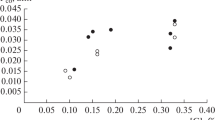Conclusion
A review has been made of all induction furnace, acid open hearth, and electric arc furnace heats which have been studied in this investigation. It has been concluded that one should not expect the vacuum fusion tests always to coincide with the indications of the solid electrolyte method, unless under closely controlled laboratory conditions.
It should be recalled that the vacuum fusion procedure indicates values of the total oxygen present in the steel. This amount includes both the combined oxygen as non-metallic inclusions and the uncombined or “free” oxygen. During the non-equilibrium (refining) stages of commercial heats, there are many periods when the liquid steel contains suspended oxides, which have not had an opportunity to be eliminated to the slag. In addition, the steel contains free or uncombined oxygen which is present in larger quantities than specified by the carbon-oxygen equilibrium. It is this latter “free” or uncombined oxygen that will be indicated by the solid electrolyte method.
However, this difference between the two methods only increases interest in the O-Probe, because it indicates the active oxygen that must be controlled to properly refine the heat. Because of the instantaneous response of the probe, changes in the refining procedure may be made accordingly.
In addition, although the vacuum fusion data are postmortem, the difference between these values and the indications of the probe should provide information regarding the non-metallic inclusions or the oxides present. Consequently, for certain investigations it is recommended that both tests be used. Such a combination could go a long way towards the development of refining processes able to produce steels of maximum quality.
Similar content being viewed by others
References
G. R. Fitterer, Journal of Metals, August 1966.
G. R. Fitterer, Journal of Metals, September, 1967.
C. D. Cassler and G. R. Fitterer, National Open Hearth Proceedings, AIME, 1965, p. 137.
G. R. Fitterer and J. W. Linhart, Proceedings Open Hearth Conference, 1947.
Author information
Authors and Affiliations
Rights and permissions
About this article
Cite this article
Fitterer, G.R., Cassley, C.D. & Vierbicky, V. The Rapid Determination of Oxygen in Commercial Steel with the Solid Electrolyte Probe. JOM 20, 74–76 (1968). https://doi.org/10.1007/BF03378725
Published:
Issue Date:
DOI: https://doi.org/10.1007/BF03378725




